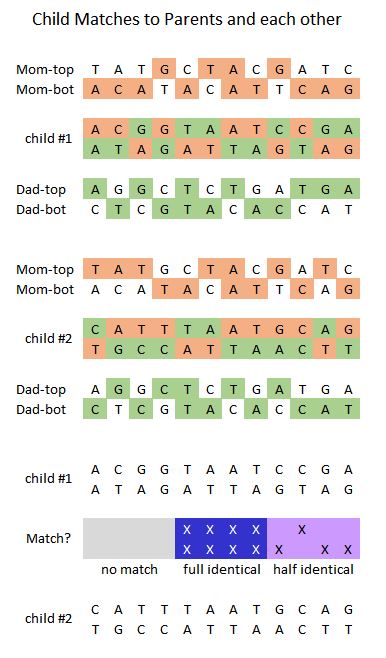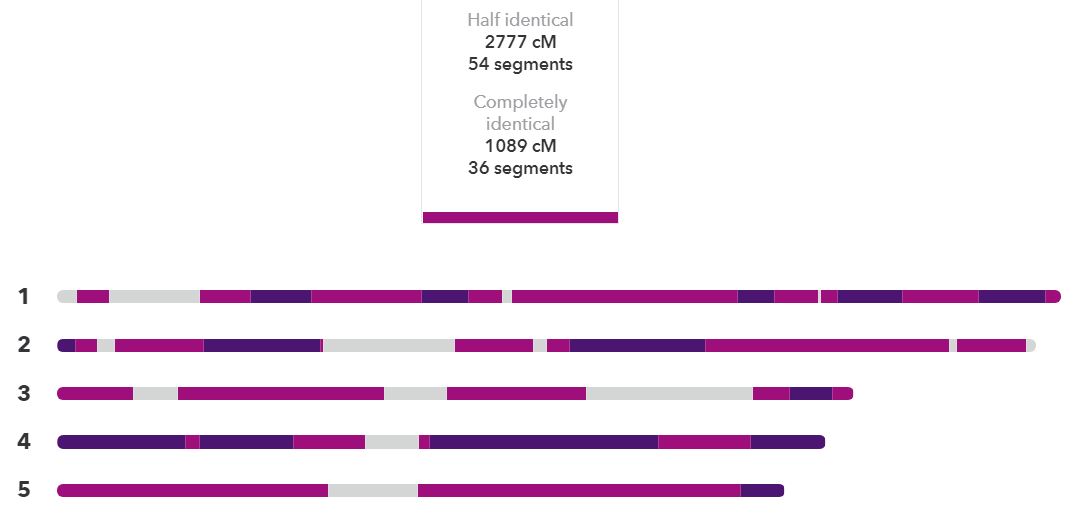DNA Basics
 Once DNA Match segments are loaded to the database and comparison tool, they can be viewed on the webpage sorted by 1) Chromosome number,
2) Match location starting SNP number, and 3) largest Match location ending number. The simple sorting and visualization of the data can lead to
discoveries. It allows you to see your DNA matches in a way that reveals the "relatives in common" data in a much simpler way.
To start, remember that each chromosome in your DNA has 2 sides - one from your mother and one from your father. So if you have a "DNA match",
that means that the matching person and you, and one of your parents, all share some DNA in that matching segment. But which parent or "side"
(paternal or maternal) is the match on? The goal is to figure that out by using known relatives and their matching segments to line up the
unknown matches and see where the common link comes from. But knowing only whether these matches with unknown connections are simply maternal
or paternal is not enough - usually we are tracking down connections from many generations back. Having a good number of DNA matches that are known
2nd, 3rd, and 4th cousins (and how they fit in your family tree), is the key to solving the unknown matches.
So what really is a DNA "match"? The DNA we have from both parents on each chromosome is a series of pairs of "snips" or SNP's that are the
C's, T's, G's, and A's that make up our "code". Since there are only 4 "letters" in the DNA alphabet, there are lots of locations on our chromosomes
that randomly match any other person. So the test of whether a series of SNP's (a segment) constitutes an ancestral match vs. something common
to lots of humans is a LONG string - hundreds of matching SNP's - vs. just a few.
Once DNA Match segments are loaded to the database and comparison tool, they can be viewed on the webpage sorted by 1) Chromosome number,
2) Match location starting SNP number, and 3) largest Match location ending number. The simple sorting and visualization of the data can lead to
discoveries. It allows you to see your DNA matches in a way that reveals the "relatives in common" data in a much simpler way.
To start, remember that each chromosome in your DNA has 2 sides - one from your mother and one from your father. So if you have a "DNA match",
that means that the matching person and you, and one of your parents, all share some DNA in that matching segment. But which parent or "side"
(paternal or maternal) is the match on? The goal is to figure that out by using known relatives and their matching segments to line up the
unknown matches and see where the common link comes from. But knowing only whether these matches with unknown connections are simply maternal
or paternal is not enough - usually we are tracking down connections from many generations back. Having a good number of DNA matches that are known
2nd, 3rd, and 4th cousins (and how they fit in your family tree), is the key to solving the unknown matches.
So what really is a DNA "match"? The DNA we have from both parents on each chromosome is a series of pairs of "snips" or SNP's that are the
C's, T's, G's, and A's that make up our "code". Since there are only 4 "letters" in the DNA alphabet, there are lots of locations on our chromosomes
that randomly match any other person. So the test of whether a series of SNP's (a segment) constitutes an ancestral match vs. something common
to lots of humans is a LONG string - hundreds of matching SNP's - vs. just a few.
 If a child and both parents did DNA tests, we would expect that the child fully matches both parents. But the DNA test cannot tell which SNP on each
side of the child's chromosome and location came from which parent. But if one side or the other matches either side of a parent, and this carries on for
a significant length of SNP's (all of them for a parent), then we know we have a match.
If we label the parent DNA pair as "top" and "bottom" (e.g. Mom's pair is M-top and M-bot, and same with P-top and P-bot), then a child could have
various combinations of one of each of these at every chromosomal location.
If a child and both parents did DNA tests, we would expect that the child fully matches both parents. But the DNA test cannot tell which SNP on each
side of the child's chromosome and location came from which parent. But if one side or the other matches either side of a parent, and this carries on for
a significant length of SNP's (all of them for a parent), then we know we have a match.
If we label the parent DNA pair as "top" and "bottom" (e.g. Mom's pair is M-top and M-bot, and same with P-top and P-bot), then a child could have
various combinations of one of each of these at every chromosomal location.
 Since there is recombination/crossover each time parental DNA is passed to a child, the children get different combinations of each parent's pair
of chromosomes in each location along the child chromosome.Of course top and bottom are really just a way to mark the parent's segments that we passed down, but it's easier to
think of it this way for the example. So if in a particular location I inherited M-top and P-top from my parents, but my brother randomly got M-bot and P-bot,
then we don't match at all in that location. If we match on one but not the other, then we are "half-identical" in that location or region (also known as HIR),
and if both match, then we are fully or completely identical in that region. The DNA comparison graph shows how this looks with me and my brother. Gray areas are
no match, purple is half-identical, and dark blue is full-identical.
If we could zoom in on the 23andMe matching graph and look at what's going on at a SNP level, and infer a possible "inheritance" of those SNP's from the
parents, it might look like the second chart (zoomed in from the first one) showing how child #1 and child #2 got their SNP's from their parents, and
how and where the children match each other. Again, top and bottom are just made up for notation, because the DNA test data does not preserve which
strand of DNA the two SNP's at each location came from. In the comparison chart between children, the regions are a fictional example with only 4 SNP's
each - in reality, they would be hundreds or thousands of SNP's long, not just 4.
I have chosen to show matches from Dwight's Mom's side in pink/orange/red/yellow tones, while those on his Dad's side are shown with blues and greens. I also
refer to Mom's side as "M" and Dad's as "P", for Maternal and Paternal respectively.
If you follow that P / M pattern for the parents at each higher level in the family tree, you have a tagging code of letters that is simpler/shorter
than using the actual names, indicates the number of generations "back", plus is "universal" no matter who is the home or reference person.
Some of Dwight's 1st and 2nd cousins have also tested and we already know if they are on his Mom's or Dad's side, so I can also color code their matching segments for
the corresponding "Line" that they are related to him on. If we extend this tagging and color scheme to more distant cousins, we can easily visualize where
our matches and segments come from (example below for Dwight).
Since there is recombination/crossover each time parental DNA is passed to a child, the children get different combinations of each parent's pair
of chromosomes in each location along the child chromosome.Of course top and bottom are really just a way to mark the parent's segments that we passed down, but it's easier to
think of it this way for the example. So if in a particular location I inherited M-top and P-top from my parents, but my brother randomly got M-bot and P-bot,
then we don't match at all in that location. If we match on one but not the other, then we are "half-identical" in that location or region (also known as HIR),
and if both match, then we are fully or completely identical in that region. The DNA comparison graph shows how this looks with me and my brother. Gray areas are
no match, purple is half-identical, and dark blue is full-identical.
If we could zoom in on the 23andMe matching graph and look at what's going on at a SNP level, and infer a possible "inheritance" of those SNP's from the
parents, it might look like the second chart (zoomed in from the first one) showing how child #1 and child #2 got their SNP's from their parents, and
how and where the children match each other. Again, top and bottom are just made up for notation, because the DNA test data does not preserve which
strand of DNA the two SNP's at each location came from. In the comparison chart between children, the regions are a fictional example with only 4 SNP's
each - in reality, they would be hundreds or thousands of SNP's long, not just 4.
I have chosen to show matches from Dwight's Mom's side in pink/orange/red/yellow tones, while those on his Dad's side are shown with blues and greens. I also
refer to Mom's side as "M" and Dad's as "P", for Maternal and Paternal respectively.
If you follow that P / M pattern for the parents at each higher level in the family tree, you have a tagging code of letters that is simpler/shorter
than using the actual names, indicates the number of generations "back", plus is "universal" no matter who is the home or reference person.
Some of Dwight's 1st and 2nd cousins have also tested and we already know if they are on his Mom's or Dad's side, so I can also color code their matching segments for
the corresponding "Line" that they are related to him on. If we extend this tagging and color scheme to more distant cousins, we can easily visualize where
our matches and segments come from (example below for Dwight).
| Family Line Key: |
PPP | PPM |
PMP | PMM |
MPP | MPM |
MMP | MMM |
| PP | PM |
MP | MM |
| Dad = Paternal |
Mom = Maternal |
| Dwight |
| Family Line Key: |
Goggans | Galbreath |
Moore | George |
Stone | Bethany |
Wiginton | Hoagland |
| Albert T Goggans | Cynthia E Moore |
John H Stone | Amanda C Wiginton |
| Cleveland Goggans | Carrie Stone |
| Dwight |
Go to the
Help Table of Contents or
Next Page
 Our Folks 2.0 - Goggans Genealogy
Our Folks 2.0 - Goggans Genealogy









